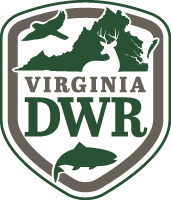The Richmond Falcon Cam live stream is scheduled to return in March 2026. Please check back and sign up below to receive the latest updates directly in your inbox! In the meantime, please enjoy this video of the banding of the 2021 Richmond peregrine falcon chicks.
What’s Happening at the Nest?
Following the completion of FledgeWatch we’ve been periodically scanning the surrounding building signs and rooftops. In that time, we’ve seen the adults and the fledglings on numerous occasions. As the fledglings age, they will begin making larger movements and spend less time in the general vicinity of the nest box. With that in mind, we will be shutting off the camera stream on Wednesday, 6/25.
We want to extend a very sincere thanks to all of our viewers and we look forward to bringing you the stream again early next spring!
We are grateful to the property managers who graciously granted us access to their buildings, which gave us a much-needed bird’s-eye view of the downtown Richmond landscape. We would also thank our partners at Comcast for their sponsorship and all of our viewers for diligently tuning in throughout the season!
And, if you still haven’t had your fill of the falcons, fear not…you can always make a trip downtown in the coming weeks to see if you can spot the birds yourself!
12:09 pm Update: DWR Staff arrived on site at approximately 9:00 am and quickly located two of the three fledglings.
White was detected atop Towne Bank shortly after our arrival. Around 11:00 am he left his perch, displaying some impressive altitude gain with his flight, before ultimately landing on the New Dominion building where he is currently perched. At this point, the team is incredibly confident in his ability to navigate both flight and landings within the city.
Shortly after arrival, a second fledgling was detected atop the Bank of America building. Based on the birds size and a few glimpses of the band, we are almost certain this is Red. As a reminder, she had a collision yesterday, so we are happy to have located her so quickly on top of one of the taller buildings in the city. She remains here at the time of this writing and we hope we get the observation to see her flight behavior at some point this afternoon.
We have not yet located the third fledgling, Blue. Although our team downtown is continuing to search.
3:25 pm Update: Following our last update, Red left her perch atop Bank of America around 2:00 pm and after a short bout of flight, ultimately landed on the roof of the Riverfront West Tower, out of sight of our observers. Blue was spotted shortly thereafter when he landed atop the First National Bank Building. He remained in this location for a few minutes before taking off towards the Towne Bank building. He displayed strong flight and landing skills during this time. Finally, White has continued to fly over Kanawha Plaza periodically, but at the moment remains perched atop the New Dominion building along the same ledge that he utilized repeatedly yesterday.
At this point our team is feeling confident in the skills displayed by each bird and will be leaving the city around 4:00 pm. We will continue to utilize the camera to search for fledglings and adults on some of their known favorite locations, but do not feel a third monitoring day is warranted at this time.
As of 11:00 am on Tuesday, June 10th, all three falcons have left the pen! We have a map highlighting various hotspots of activity from previous years, found here. You can use this to orient yourself as to the various locations of the birds throughout the day!
Updates:

Blue (left) and Red (right) perch together atop a light on the Riverfront Plaza’s West Tower.
11:03 am: The pen was opened at approximately 10:15 am. White was the first to leave just a few minutes after the pen opened. After circling above Kanawha Plaza for a few minutes he ultimately landed atop the Truist roof on the south-facing side, where he remains currently perched.
Blue walked out of the pen at approximately 10: 55 am and hopped on top of the parapet wall. He was followed shortly after by Red who also hopped up on the wall. Both birds remain perched at this location near the camera atop the Riverfront Plaza West Tower.
4:06 pm: At the time of this writing, we have known locations on each of the three fledglings. Blue and Red both left the parapet wall within minutes of one another at approximately 1:20 pm.
Blue quickly circled back and landed once again on the West Tower where he remains as of now. One of the adults delivered a prey item to him at approximately 3:00 pm.
Red took flight shortly after Blue and after momentarily circling the air above Kanawha Plaza, she flew back around the south side of Riverfront Tower and ultimately collided with a sliding glass door associated with a residence at the Locks Tower. After the collision she landed on the balcony of the residence, out of our staffs view. Fortunately, we were able to get in contact with the resident of this unit and were on the way to that private balcony when Red reappeared, hopped on a railing, and then took flight once more approximately thirty minutes or so after her initial collision. From here, she flew east and landed atop a historic tower associated with Richmond’s Canal Walk. Roughly two hours later, she left this tower following some slight harassment from a red-tailed hawk and attempted to land on one of the Riverfront Towers. She miscalculated this landing and instead circled lower, landing on top of the Locks Tower roof, where she remains currently
White has displayed the most flight out of the group thus far. He left the Truist building around 1:00 pm and after some circling above Kanawha Plaza, landed atop the New Dominion building. He stayed here for roughly 30 minutes before he returned to his perch on the south-facing Truist roof. Roughly an hour later, he returned to the new Dominion building albeit on a different perch located behind the facade where he remains currently.
8:15 pm: DWR staff concluded monitoring efforts at approximately 6:00pm today. At that time, Red was presumed to still be atop the Locks Tower roof, while Blue and White were suspected to be on top of the Riverfront Plaza West Tower. DWR staff will be reconvening tomorrow morning for a second day of monitoring with updates to follow, as time permits.

Red (on the left) and Blue (on the right) perched atop the Riverfront West Tower parapet ledge shortly after leaving the pen.
- Read more updates in the archive…


Internet service to the Falcon Cam provided courtesy of Comcast Business.
The DWR Falcon Cam follows the breeding season of a peregrine falcon pair that nests in downtown Richmond, Virginia. The nest box is located atop the Riverfront Plaza building. If you’re in the area, look up! You may catch a glimpse of the famous birds! We hope each year that the pair will once again choose to nest at this site, so that our camera may provide an educational experience for all to enjoy.

